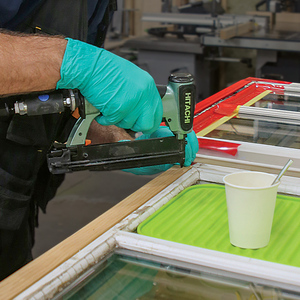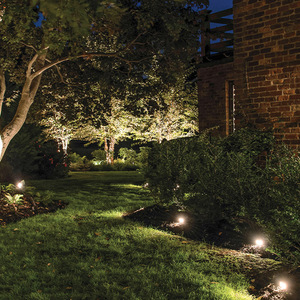New bathroom – still in the rough in stage and it was decided that we need a linen closet in the bathroom. It will be small – like roughed out to 24″ x 30″. Again, new construction so the room will have proper ventilation, vapor barriers, etc.
The question is – do I use a solid door or a louvered door for the linen closet?
I see it both ways. Louvered lets the moisture out of the closet. Solid keeps the moisture out. Or does it?
I don’t want to trap moisture in the closet in the towels, etc. with a solid door, nor do I want to let moisture in with a louvered door. Or do I?
I know the answer is to eliminate the closet, but that’s not happening.
Any ideas?
Thanks.



















Replies
Humidity is why linen closets are usually placed in hallways. That and full time accessibility.
Edited 6/30/2009 12:18 pm by Hudson Valley Carpenter
Hi CCI,
New bathroom - still in the rough in stage and it was decided that we need a linen closet in the bathroom. It will be small - like roughed out to 24" x 30". Again, new construction so the room will have proper ventilation, vapor barriers, etc.
That's your key point.....properly ventilated....as long as you have the proper ventilation the moisture you are concerned about will never be an issue. Fan on with proper flow, then shower, then leave fan on for approx. 15-20 minutes. As such you'll never build up enough moisture in the closet to be an issue. Keep rotating your towels and match the door to the decor.
Pedro the Mule - Nothing like a fresh towel after a hot shower
Either will be OK, it all depends on lifestyle. I would use solid because the wife throws baby powder all over the place and the towels are very dry from the dryer. I am in Southern Calif, so it is very low humidity.
Louvered will freshen the smell of the room if you use Downey. Most wives always has a preference, so its her decision. Most men just do what the women say, even if it involves a change of mind.
Also, you can order both doors, which is priceless for peace of mind.
A normal closet door will be undercut at the bottom for clearance, and not be sealed at all four edges as in a casement window. Thus water vapor will migrate into the closet while you shower, and back out as the fan continues to run afterward, regardless of there being louvers in the door.
Having access to towels, toilet paper, and various medications without a perhaps drippping wet trip to a hallway closet can be handy for the forgetful. Sheets and things like that can go elsewhere. It's a matter of preference and good use of available space. Just do the ventilation right; install a timer at least.
I guess it is personal preference and I will ask her what she prefers.
Since it is new construction with everything still open and accessible is it better to oversize the vent fan? I know they go by square footage and I am at about 75 sq. ft. so technically a small unit is ok. Is jumping up a size or 2 worth it?
On a similar note - what is a good sone rating? Some of the really quiet units are really pricey. Is there a point of diminishing returns? I don't need to hear a pin drop but I don't want to be in a wind tunnel either.
Thanks for the input.
Code generally calls for 50 CFM. Going to 75-100 CFM will make a major difference in how humidity accumulates. Anything over 100-150, though, will just turn the bathroom into a wind tunnel.I don't recall the sone ratings of units I've dealt with, but I do know that a deeper (farther in the ceiling) fan is much quieter.
As I stood before the gates I realized that I never want to be as certain about anything as were the people who built this place. --Rabbi Sheila Peltz, on her visit to Auschwitz
I installed one of these in a clients house. The motor was in the attic, several feet away.
Wired it up so either bathroom could turn the fan on. Can't hear it at all.
View Image
We redid our small main bathroom recently and installed a Panasonic Ceiling Fan. Love it. Super quiet (< 1 sone) and works like a charm. Bought it at an electrical store that the trades tend to go to rather than a bathroom store or one of the big boxes and saved a bundle (the bathroom store wanted $600 and I bought it for about $150). Also, it was easy to install.
At HD they had a nice display of fans with a comparison chart for cfm and sone rating.
With it right there it was pretty easy to choose.
the ones that were quiet and moved more air were more money. I figure it is worth it."There are three kinds of men: The one that learns by reading, the few who learn by observation and the rest of them have to pee on the electric fence for themselves."Will Rogers
I was actually playing with that display last night. The quietest sound is actually pretty silent even compared to the next quietest. The noisiest sounded like I was at the airport. It looks like they only sell Nutone (and from the replacement parts it looks like Nutone and Broan are the same company now). I have heard good things about the Panasonic (even before this post) so I will look for that as well since the best Nutone was about $125 and the Panasonic may be around that same cost.
Thanks.
If you go to a home horror store they usually have a display with several operating fans of different ratings and you can use those to get a rough idea of how quiet you want one.Of course that Is not the ideal test environment..
William the Geezer, the sequel to Billy the Kid - Shoe
Not sure if this will help you - in our pretty small bathroom we went with a linen cabinet with solid flush doors instead of a closet (which has to have clearance under the door). That way it is better sealed against the humidity in the bathroom and matches the cabinetry under the sink. The towels and sheets all seem fresh to me, but we are in the desert and even towels hanging on the rod are completely dry by the next day.
I vote with your counterpart that it belongs in the bathroom - I hate forgetting a towel and dripping out into the common room to get one.
One trick is to provide some small amount of positive ventilation, by punching a hole in a passing HVAC duct.
As I stood before the gates I realized that I never want to be as certain about anything as were the people who built this place. --Rabbi Sheila Peltz, on her visit to Auschwitz
Don't build a closet and instead place a pantry cabinet with pull out shelves. It's more expensive than walls & prehung doors but a whole lot more useful.
We install linen closets or built-ins in pretty much every bathroom we build. Never thought twice about it. If you have and use a bathroom fan it shouldn't be a problem.
You're worried about moisture in your bathroom linen closet? Are you serious?
I'm surprised this thread actually had 13 posts.
I live in NY and we get some real serious humidity in the summer. Anyone who has ever opened a closet or trunk that had been "sealed" for a while and smelled the musty odor will know why I was concerned. Dampness in closed spaces can be a real problem that's why they make dehumidifiers.
Sorry to have wasted bytes on this.
So it's a musty odor you're trying to elimate? Musty odor's anywhere come from people who are dirty and don't know how to wash linen's or re-paint, or basically keep anything clean. And of course there's the occasional dead animal in a wall that may also be decomposing which will cause a musty odor.
You're new closet will only smell new and there will only be excessive moisture if you don't install an exhaust vent.
I'm not trying to eliminate an odor I'm trying to prevent it from occurring by proper use of ventilation. If you ever spent time @ a beach house you would understand how quickly trapped moisture can turn "funky".
It is not just from dirty people nor is it from from people who confuse possessive and plural. And my housekeeper would be very upset if you criticized her laundry skills.
I appreciate the input, however.
Linen closets in England were traditionally placed next to the masonry chimney flue and had louvered doors to avoid their contents smelling musty. When my sister lived up the coast in Bamfield she had to regularly take her clothes out of her closet and run them through the dryer to avoid mold. It is a problem, you just haven't had any experience with it.
No need to apologize, it's a good question. I have used louvred doors for closets and storage spaces that were known to be damp. A better solution is to solve the moisture problem, but louvres are a valid low-tech option.
Consider my suggestion to add positive ventilation. You only need a small amount of air "spilled" from a nearby heating/AC supply duct to assure that air is "turned over" in the closet, preventing accumulating humidity and the musty odor.
As I stood before the gates I realized that I never want to be as certain about anything as were the people who built this place. --Rabbi Sheila Peltz, on her visit to Auschwitz
I like the idea of introducing "fresh" air. Unfortunately, I have hydronic heat and I am not a fan of central air. The concept is fine the execution is lacking (whole 'nother topic) so I don't have it in my house.
How about if I put a small vent in the side of the closet? Would that promote airflow through the closet when the vent fan is on? Or am I back to the same problem of letting humid air into the closet as opposed to keeping it out?
Thanks.
If you used a remote vent fan you could in theory Y the duct and put a small vent in the closet, so the fan would draw air through. But then the fan would be drawing moist air into the closet, when it would be far preferable to flush fresh air through the closet.
As I stood before the gates I realized that I never want to be as certain about anything as were the people who built this place. --Rabbi Sheila Peltz, on her visit to Auschwitz
(But you could actually put a vent to the next room or whatever in the closet, so that when the fan was on air would be drawn out of the closet and fresh air would be drawn in from the adjacent room.)
As I stood before the gates I realized that I never want to be as certain about anything as were the people who built this place. --Rabbi Sheila Peltz, on her visit to Auschwitz
Could you design it so you had access from both the bath and hall?
Door in the hallway, cabinet style door in the bathroom.